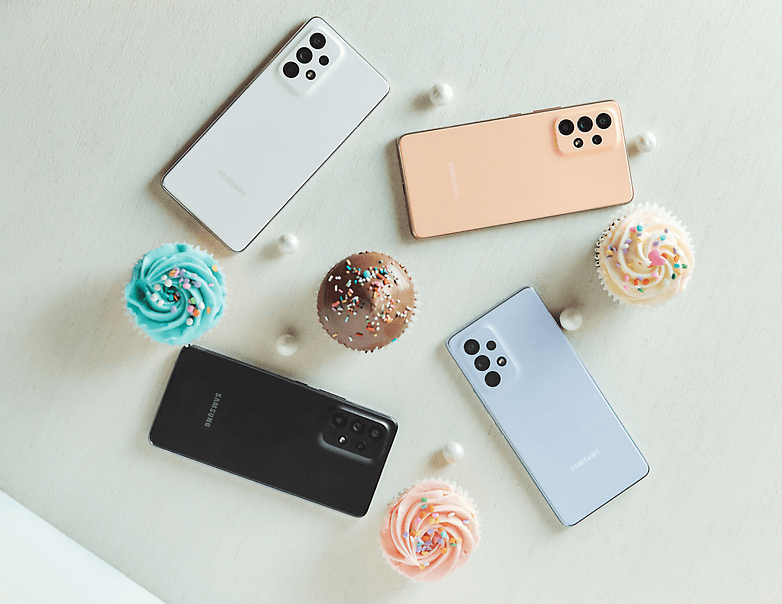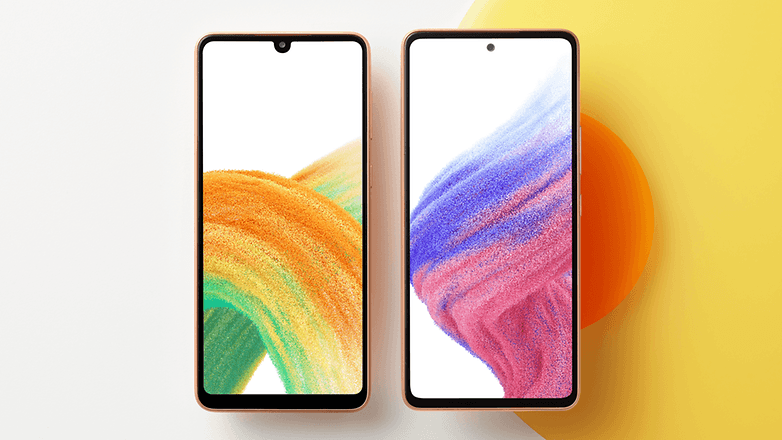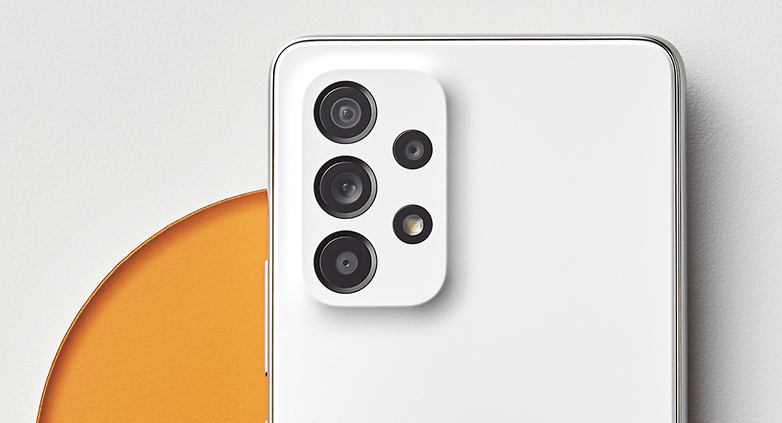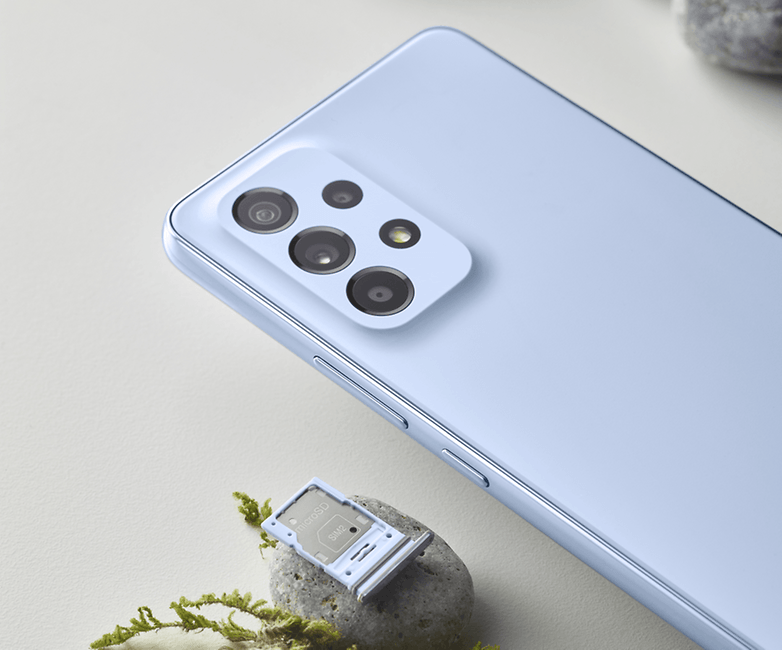
[ad_1]
Samsung once again presents us with new smartphones in the still quite young year 2022. This time, it is the company’s very popular A-Series. As usual, we will start with our overview of the most important specs of the Galaxy A53 and Galaxy A33:
All models are available for pre-order as of today, but they will not be shipped until April. Time enough for us to take a look at the differences between the two mid-range handsets beforehand.

Jump to:
Samsung Galaxy A53 vs. Galaxy A33: Display and case
If we take a look at the two smartphones, they initially look almost identical. Samsung uses Corning Gorilla Glass 5 and follows the familiar design language for both models. The camera island merges into the casing, which is IP67-certified in both devices.
Samsung itself speaks of a “nice and functional” design, which could possibly also be called a bit boring. However, we do notice a difference at the front: Only the A53 has a punch hole for the selfie cam. The A33 comes with a classic notch and has a chin that is too long for my liking.

The manufacturer still does not show any weaknesses in the display itself: The almost equally sized panels (A33 with 6.4 inches, A53 with 6.5 inches) offer an FHD+ resolution and rely on Super AMOLED technology. The display of the A33 lets you refresh pictures at 90 hertz, while the A53 manages 120 hertz. Unfortunately, the refresh rate is not adaptive, but you can manually switch to 60 hertz to save battery power. The brightness of less than 500 nits is unfortunately rather poor.
The Koreans have sustainability written all over them, and just like in the Galaxy S22 series, we also notice this in the first components of the A-Class: Both the side buttons and the SIM card slots are made of so-called “post-consumer materials”, i.e. recycled plastic.
Samsung Galaxy A53 vs. Galaxy A33: Performance and connectivity
Under the hood, there is a first, as the Exynos 1280 is brand new. As nice as that is, we cannot say much about the performance of this SoC so far. Test devices have been requested, and we will be able to tell you more in the reviews. What we know so far: The Exynos 1280 relies on eight cores that clock with up to 2.4 GHz and is manufactured in a 5 nm process.
The Galaxy A33 only comes in a single configuration with 6 GB of RAM and 128 GB of expandable storage. The A53 is additionally available with 8 GB of RAM and 256 GB of storage.
In terms of connectivity, the two devices are again absolute twins: Both are on the 5G network and are not quite up to date in terms of Wi-Fi (no Wi-Fi 6 yet) and Bluetooth (only 5.1).
Samsung Galaxy A53 vs. Galaxy A33: Cameras
As is so often the case in the mid-range, Samsung also has to do more than less when it comes to the number of camera sensors. Thus, you get four cameras on the back of both smartphones — how useful they are is of course another story. The quartet is led by a 64 MP camera in the A53 and 48 MP in the A33 — with optical image stabilization in both cases.

Both camera arrays then offer us an ultra-wide-angle cam and sensors for depth and macro. In the A53, these are shooters with 12 and 2 x 5 MP, while 8 MP, 2 MP, and 5 MP have to suffice in the A33. There is also a 32 MP camera in front for selfies.
However, Samsung mainly wants to score with new and improved camera features: Both the night mode and the portrait mode have been optimized. The latter lets you use effects and filters, as well as change the background. Compared to the predecessor, this now also works with the ultra-wide-angle camera. An eraser is also on board, which is supposed to remove unwanted people or objects from the background.
Samsung Galaxy A53 vs. Galaxy A33: Software
The software has turned into Samsung’s main discipline. The A33 and A53 also come with Android 12 and the popular One UI 4.1, but Samsung is mainly exemplary because they currently have an unrivaled update policy. The two inexpensive A-class phones also benefit from this and will receive four major Android generations and security updates for five years.
Security also plays a big role in Samsung devices and so the two new smartphones also come with Samsung Know. In addition, the “secure folder” is on board and with “Private Share” you can control who can access your files and for how long.
Samsung Galaxy A53 vs. Galaxy A33: Battery and Quick Charging
First things first: No, the chargers are not included in the box! Samsung refrains from stuffing the charging plugs into the package. According to Samsung, this is done for sustainability reasons and as part of Samsung’s “Galaxy for the Planet” initiative. We can discuss that, but Samsung explains that it is by no means only about the chargers themselves. By omitting the chargers, the packaging, which is also sustainable, can be reduced significantly.
This means lower material costs and, above all, the boxes take up much less space when they travel halfway around the world. The only question is how much more space will be saved when millions of chargers have to be shipped on the next steamer.

Anything else you need to know about the batteries? Oh, yes: Both come with a capacity of 5,000 mAh and can be charged with up to 25 watts. That Samsung calls this “superfast charging” is of course almost a bit ironic in 2022. But the combination of a large battery and 25-watt charging is actually one that should get you through everyday life quite smoothly.
Samsung Galaxy A53 vs. Galaxy A33: Price and availability
So, now of course you want to know what you’ll have to shell out for the two new phones. You should know: The A33 is only available with 128 GB of storage and costs $369.99 (MSRP).
Logically, you will have to pay a bit more for the larger A53: The model with 6 GB / 128 GB will cost $449.99 and be available on March 31 at T-Mobile and Verizon. It’ll also sell through AT&T, Samsung.com, and other retail and carrier partners beginning April 1. Samsung thus bases the price on the A52 series from last year.
You can pre-order the devices now and Samsung also wants to reward the early birds: the Galaxy Buds Live White will be included as a gift.

Samsung Galaxy A53 vs. Galaxy A33: First impressions
On paper, the new mid-range presents itself more as a selective rather than significant update of the predecessor models. Samsung refrains from offering both 4G and 5G models, which I think is right. On the other hand, I find it less right that they also do without the chargers because it also looks like a price increase through the back door to me.
However, it is fair to say that we will benefit from new SoCs, the battery is bigger, and we can look forward to improved cameras, at least according to the spec sheet. Both smartphones are priced a bit higher than some similarly equipped Chinese competitors. However, we have to be fair here as well and mention that Samsung spends money on items like IP certification that others are happy to do without.
We will only be able to finally evaluate the phones as soon as we can put them under the microscope. But until the test devices arrive in our editorial office, you can already tell us what you think of Samsung’s new A-Series in the comments.
[ad_2]








